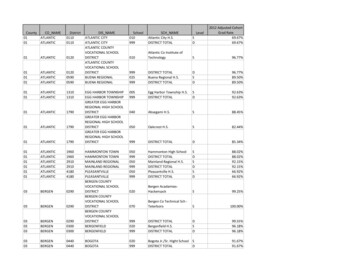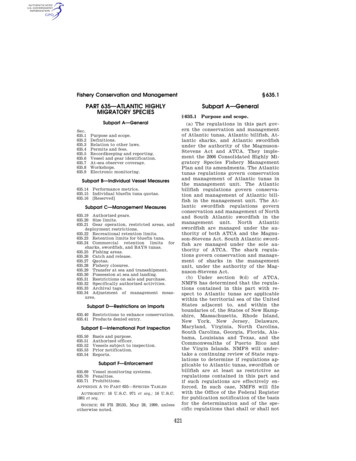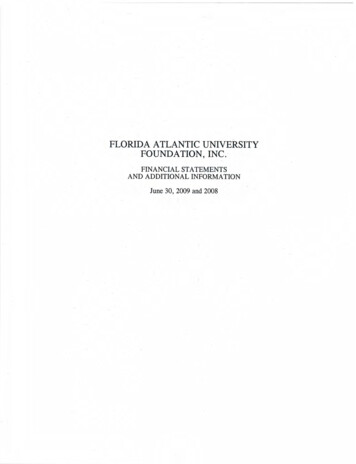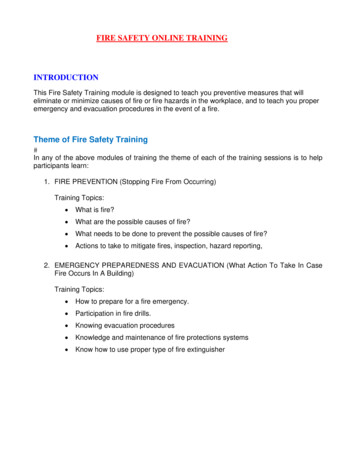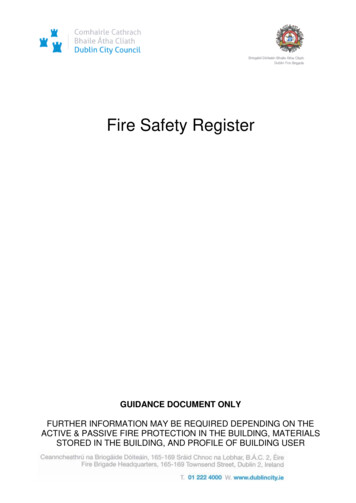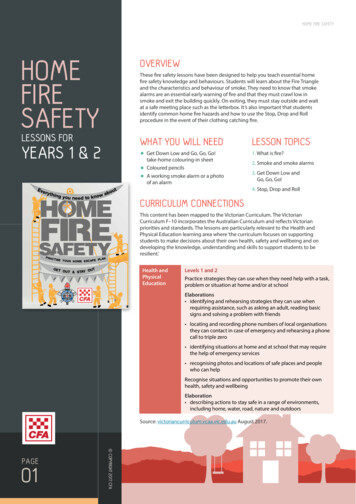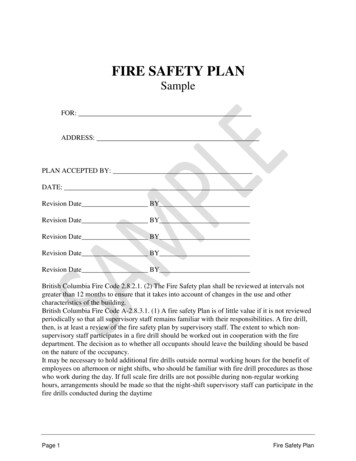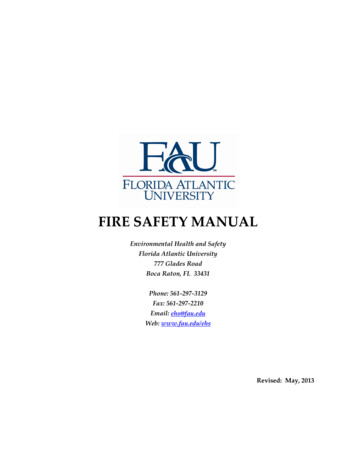
Transcription
FIRE SAFETY MANUALEnvironmental Health and SafetyFlorida Atlantic University777 Glades RoadBoca Raton, FL 33431Phone: 561-297-3129Fax: 561-297-2210Email: ehs@fau.eduWeb: www.fau.edu/ehsRevised: May, 2013
FLORIDA ATLATNIC UNIVERSITYFIRE SAFETY PROGRAM INDEX1FIRE SAFETY PROGRAM COMPLIANCE AND RESPONSIBILITIES . 51.1Introduction.51.2Implementation .51.3Compliance and Responsibilities .51.4Responsibilities .51.4.1 The President of the University .51.4.2 Vice-Presidents, Deans, Chairs, and Directors .51.4.3 Supervisors.61.4.4 Employees .61.4.5 Students .61.4.6 Environmental Health & Safety .61.4.7 Physical Plant .61.4.8 Housing and Residential Life .71.4.9 Facilities Planning .71.4.10 Contractors .72FIRE PREVENTION MEASURES . 72.1Program Strategies .72.2Fire Prevention Plan: .82.3Program Elements will include: .82.3.1 Prevention Measures .82.3.2 Housekeeping .92.3.3 Electrical Wiring and Appliances.934GUIDELINES FOR FIRE SAFETY EDUCATION AND TRAINING . 103.1Fire Safety Training for Office Employees .103.2Fire Safety in Residence Halls .113.3Fire Safety Training for Crowd Managers .113.4Fire Safety Training for Building Supervisors .113.5Fire Safety Training for Laboratory Employees .123.6Theme of Fire Safety Training .123.7Fire Extinguisher Training .13EMERGENCY EVACUATION PROCEDURES . 134.1Emergency Evacuation .134.1.1 General Information .134.1.2 Individuals Requiring Assistance .141
5FIRES AND FIRE SAFETY . 165.1678General Information .16PROCEDURES FOR FIRE DRILLS . 176.1General Information .176.2Purpose of Fire Drills: .176.3General Fire Drill Procedures .17FIRE SAFETY REQUIREMENTS FOR MEANS OF EGRESS (DOORS and CORRIDORS) AND FIRE LANES . 187.1Introduction.187.2Basic Requirements for Means of Egress lls .207.4Minimum Widths.207.5Obstructions and Protrusions .207.6Items Not Permitted in Corridors/Hallways .207.7Atriums and Large Corridors .207.8Fire Lanes .21PLANNING AND MANGEMENT GUIDE FOR PUBLIC ASSEMBLY OR SPECIAL EVENTS . 218.1General information on Event Planning .218.1.1 Fire and Life Safety .218.1.2 Definition of Public Assembly .228.1.3 Stages .228.1.4 Use of Tents and Canopies.228.1.5 Large scale Events .248.1.6 Fire and Life Safety Planning and Management Information .24910STORAGE FIRE SAFETY . 289.1General Storage .299.2Flammable Storage .299.3High Stack Storage .309.4Housekeeping, Maintenance, and Protection of Storage Spaces .30ELECTRICAL FIRE SAFETY . 3010.1Electrical Hazards Control .3110.1.1 Engineering Controls .3110.1.2 Administrative Controls .3110.1.3 Personal Protective Equipment .3110.1.4 Training Requirements .3210.1.5 Qualified Electrical Worker .322
10.1.6 Portable Electrical Equipment and Extension Cords .3210.1.7 Requirements for Temporary Wiring .3410.1.8 Working on Wet or Damp Locations.3510.1.9 Working on De-Energized Equipment.3510.1.10 Electrically Safe Condition .3510.1.11 Working Space around Electric Equipment .3510.1.12 Contractor Employees .3710.1.13 Electrical Fire Prevention Tips.3711FIRE SAFETY PROGRAM IN THE RESIDENCE HALLS . 3811.1Residence Hall Fire Safety Program Objectives .3811.2On-Campus Student Housing Fire Protection Equipment and Systems .3811.3Fire Prevention Policies and Procedures:.3811.3.1 Policy on Holiday Decorations .3911.3.2 Policy on Electrical Equipment and Appliances .3911.3.3 Policy on Electrical Safety .4011.3.4 Policy on Tampering .4011.3.5 Candle and Open Flame Safety .4111.3.6 Cooking Safety .4111.3.7 Policy on Smoking Safety .4111.3.8 Policy and Procedure on Fire Drills .4211.3.9 Emergency Evacuation Procedures.4211.3.10 Fire Alarm Reporting and Evacuation Protocols .4311.3.11 Policy on Fire Safety Inspections .4311.3.12 Policy on Fire Safety Education and Training .4312FIRE EXTINGUISHER PROGRAM . 4512.1The Fire Triangle .4512.2Classes of Fires .4612.3Types of Fire Extinguishers .4612.4How to Use a Fire Extinguisher .4712.5Rules for Fighting Fires .4812.6Mounting Fire Extinguishers.4812.7Tampering/Vandalism .4912.8Reporting Damaged or Discharged Extinguisher .4912.9Maintenance .4912.1013Guidelines for Inspection and Maintenance of Fire Extinguishers .49INSPECTION AND TESTING OF FIRE PROTECTION AND LIFE SAFETY SYSTEMS . 5113.1Fire Protection Equipment and Systems .5113.2Servicing, Testing, and Maintenance .5213.3Service Tags .523
13.4New Installation .5213.5Upgrade of Equipment .5213.6Inspection and Maintenance Records .5213.7Notification of Systems Out of Service .5313.8Life Safety Systems .5313.8.1 Fire Alarm Systems .5313.8.2 Test of Systems .5313.8.3 Emergency Lighting Systems.5313.8.4 Generator Systems .5313.8.5 Battery Systems .5413.8.6 Emergency Power Supply Systems (EPSS) .5413.8.7 Engine Driven Generator Systems .5413.8.8 Test of Automatic Fans and Dampers .5413.9Waterbased Life Safety Systems .5413.9.1 Automatic Sprinkler Systems .5413.9.2 Fire Department Connections.5513.9.3 Fire Pumps .5613.9.4 Private Fire Service Mains .5613.10Fire Doors and Dampers .5713.10.1 Fire Door Inspection .5713.10.2 Fire Door Testing.5713.10.3 Fire Damper Inspections .5713.11Special Fire Suppression Systems .5813.11.1 Commercial Kitchen Hood Systems .5813.11.2 “Type K” Extinguishing Systems and Portable Fire Extinguishers .5813.11.3 Fixed Dry Chemical Extinguishing Systems .5813.11.4 Fixed Wet Chemical Extinguishing Systems .58Appendix 1 – Fire Drill Response Form. 59Appendix 2 - FAU Event Planning Checklist . 60Appendix 3 - Summary of Minimum Inspection, Testing and Maintenance for Sprinkler Systems, NFPA 25 . 63Appendix 4 - Summary of Fire Pump Inspection, Testing, and Maintenance . 64Appendix 5 - Inspections, Testing and Maintenance-Fire Alarm System . 65Appendix 6 - Fire Detection and Alarm Systems Monthly Tests and Maintenance . 68Appendix 7 - Fire Detection and Alarm Systems Monthly Inspection . 69Appendix 8 - Fire Detection and Alarm Systems Annual Test and Maintenance . 704
1 FIRE SAFETY PROGRAM COMPLIANCE AND RESPONSIBILITIES1.1IntroductionThe mission of our fire safety program is to broadly increase fire safety awareness, reduce the riskand number of fires, reduce loss of life, injury and property damage through education training andinspection as well as policy and standard development. Our strategy to reduce fire deaths andinjuries is to focus on prevention by identifying and rectifying unsafe behaviors. The National FireProtection Association (NFPA) and the Occupational Safety and Health Administration (OSHA) arethe primary standards used in the development of this Manual. Any area not specifically coveredmay be referenced in one of the above standards and will apply as necessary.1.2ImplementationCampus fire safety is a vitally important area of concern for FAU. The potential for loss of life orinjury from a fire-related incident is one of the most serious risks a university must face. Therefore,an institution of higher education must have a comprehensive fire safety program. It requires anon-going commitment on the part of the community, the institution, and the administration. Carefulplanning, implementation, and maintenance are all essential ingredients of a successful fire safetyprogram.1.3Compliance and ResponsibilitiesDue to the danger of injury or death from fire-related emergencies, faculty, staff, students andcontractors as well as visitors must comply with this program. Any hazardous or emergencysituation must be reported to the proper authorities. Failure to do so could result in the possibleloss of life and property. Persons who knowingly and/or willingly violate the provisions of thisprogram may be subject to disciplinary action. The responsibilities for campus fire prevention reston all levels of the University and are outlined as follows:1.4Responsibilities1.4.1The President of the University1.4.2As the chief executive, has ultimate responsibility for establishing and maintainingenvironmental health and safety programs for the University, and provides continuingsupport for the Fire Safety Program.Vice-Presidents, Deans, Chairs, and DirectorsThese administrators are responsible for enforcing fire safety programs in areas under theircontrol, and providing assistance to EH&S in conducting safety inspections, correctingviolations, and implementing fire prevention and evacuation policies as well as encourageand require employees to participate in fire safety trainings and awareness programs.5
1.4.31.4.41.4.51.4.6SupervisorsSupervisors must brief employees on the specific hazards of their work area, on firereporting and evacuation plans, and fire extinguisher locations. They will be exemplary infire prevention and require them to participate in fire drills so that they become familiarwith the area escape planEmployeesNew employees, when attending the initial orientation, will receive an overview of the safetyprograms provided by EH&S and should become familiar with the services. The orientationwill focus on fire prevention techniques in the work area as well as what to do in case thereis a fire emergency. Employees should comply with fire safety policies and guidelines, reportany unsafe condition and receive training as required.StudentsStudents should familiarize themselves with the fire safety guidelines of FAU and thoseliving in Residence Halls shall also be familiar with Housing and Residential Life rules. Theyshould report vandalism and fire hazards to EH&S or Housing and Residential Life. They willbe required to evacuate the building during a fire emergency and proceed to pre-determinedassembly areas of their buildings and wait there until told to re-enter the building.Environmental Health & Safety 1.4.7Provides a fire-safe environment for employees, faculty, students and visitors.Coordinates and reports code compliance inspections.Responds to fire incidents and does the follow-up.Assists in the response to reports from the State Fire Marshal and the follow up.Acts as liaison to other local and state regulatory agencies related to fire and life safety.Assists and advises University departments on matters relate to fire and life safetyissues.Participates in the design of fire detection and alarm system standards.Monitors fire detection and fire suppression systems.Develops and publicizes university fire program and policy.Serves on the University Safety Committee.Conducts emergency evacuation exercises.Provides fire safety education and training.Review plans.Participates in the design, construction, and renovation of buildings through the processof plans review and construction inspections.Physical Plant Inspects, tests, and maintains fire detection and suppression systems.Inspects and tests emergency exit signs and lighting and other life safety systems.Corrects fire code deficiencies in a timely manner.6
1.4.8Housing and Residential Life 1.4.9Assists in the design of fire suppression, detection and alarm systems.Provides fire safety education for student residents and housing staff.Conducts monthly in-house code compliance inspections for residence halls andapartments.Participates on the University Fire Safety awareness programs.Inspects, tests, and maintains all fire safety equipment.Assists and coordinates emergency evacuation exercises for housing units.Corrects fire code violations in a timely manner.Facilities Planning Develops and maintains a university design manual.Develops fire suppression and detection system specifications.Participates on University Fire Safety awareness strategies.Ensures Life Safety Code Compliance for new and renovated buildings.Executes fire code corrections that require Capital Outlay funding.1.4.10 ContractorsComply with local, state, and federal safety standards. If the contractor has an establishedprogram that meets or exceeds FAU policy, it may be used on the job site. If the contractordoes not have such program, FAU policies may be mandated. The more restrictiverequirements will apply.2 FIRE PREVENTION MEASURES2.1Program StrategiesFires require fuel, an adequate oxygen supply, and an ignition source to start. Fire prevention isaccomplished by maintaining control over one of the three required elements that, when broughttogether, cause fires. The strategies we follow will include the following:1. Implement a program that targets preparation, prevention and emergency preparednessand evacuation.2. Proper handling of combustible and flammable materials. FUEL LOADS.3. Proper handling and control of all ignition sources. FUEL SOURCES.4. Implement safe housekeeping practice that reduces the risk of fire danger.5. Install a reliable fire protection system and maintenance procedures.7
6. Disseminate fire safety information through education, training and other means ofawareness program.2.2Fire Prevention Plan:The purpose of the plan is to eliminate the causes of fire and prevent loss of life and property byfire. The plan provides faculty, staff and students with information and guidelines which will assistin recognizing, reporting and controlling as well as eliminating the causes of fires and fire hazards.2.3Program Elements will include:1. Identifying potential fire hazards one of which is the proper handling of combustible andflammable materials.2. Control and proper usage of ignition sources mainly electricity which is the major ignitionsource in all occupancies. Ignition sources also exist in chemical and mechanical forms.Smoking, open flames like candles and hot burners as well heat producing elements.The major causes of fire at the workplace include poor housekeeping, improper storage and use offlammable materials, overloaded electrical outlets and extension cords, misuse of heat producingappliances including space heaters, unsupervised cooking, and improper disposal of smokingmaterials on campus grounds. Implementing fire prevention measures is the key in an attempt toinsure one’s personal safety.2.3.1 Prevention MeasuresMake certain that a copy of the "Fire and Emergency Procedures" is posted in a conspicuouslocation on each floor.Have an understanding and knowledge of the contents of the "Fire and EmergencyProcedures."Recognize all possible risks associated with an activity or process and eliminate it bycontrolling sources of ignition and properly managing combustible and flammables.Regularly observe emergency evacuation routes, fire extinguishers, and emergency and exitlights. Immediately report any
FIRE SAFETY MANUAL . Environmental Health and Safety . Florida Atlantic University . 777 Glades Road . Boca Raton, FL 33431 . Phone: 561-297-3129 . Fax: 561-297-2210
